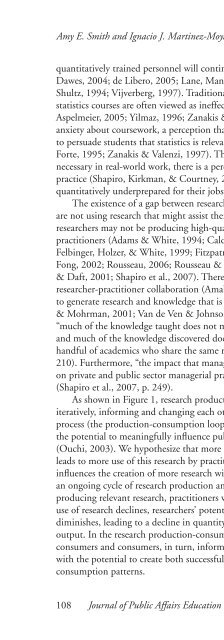WINTER 2012 - National Association of Schools of Public Affairs and ...
WINTER 2012 - National Association of Schools of Public Affairs and ...
WINTER 2012 - National Association of Schools of Public Affairs and ...
Create successful ePaper yourself
Turn your PDF publications into a flip-book with our unique Google optimized e-Paper software.
Pamela A. Gibson <strong>and</strong> Pamela Trump Dunning<br />
enhancements <strong>and</strong> fixes, but they can also require changes in course design<br />
<strong>and</strong> access for both students <strong>and</strong> instructors. For instance, although the latest<br />
iteration <strong>of</strong> Bb, Blackboard Collaborate, provides opportunities to enhance<br />
online activities, instructors have a short time frame to familiarize themselves<br />
<strong>and</strong> experiment with these applications before launch, <strong>and</strong> this restriction can<br />
make the programs less effective. The fluid <strong>and</strong> accelerated pace <strong>of</strong> s<strong>of</strong>tware<br />
development requires up-to-date training <strong>and</strong> adaptability to change for all<br />
participants in the process.<br />
The goals <strong>of</strong> the QAI, according to Dr. Fortune, are better retention <strong>and</strong><br />
lower attrition rates for class enrollments (D. Fortune, August 11, 2011).<br />
Incorporating quality course design principles into course delivery would appear<br />
to be beneficial to both the student <strong>and</strong> the instructor; however, only time <strong>and</strong><br />
sufficient collected data will tell if, in fact, QA contributes to increased student<br />
learning as suggested by others (Fisher & Baird, 2005). End-<strong>of</strong>-term course<br />
survey results indicate improved student satisfaction in the MPA program.<br />
Student comments have been positive as they relate to faculty responsiveness <strong>and</strong><br />
feedback; they report greater comfort in online course participation, in part due<br />
to the st<strong>and</strong>ardized course design <strong>of</strong> the program. By the second online class,<br />
students underst<strong>and</strong> where certain information is contained in the syllabus,<br />
where to find information in the Bb course, <strong>and</strong> have the same expectations <strong>of</strong><br />
faculty feedback <strong>and</strong> responsiveness. Certainly, additional research on the impact<br />
<strong>of</strong> the QA course design on student outcomes will benefit the program, especially<br />
as course learning objectives are refined to link to the 2009 NASPAA st<strong>and</strong>ards.<br />
To be compliant with the 2009 NASPAA st<strong>and</strong>ards, the MPA program is<br />
exploring how to refine objectives, competencies, <strong>and</strong> assessment measures <strong>of</strong><br />
student learning for all universal required competencies, all mission-specific<br />
required competencies, <strong>and</strong> all elective (option, track, specialization, or<br />
concentration) competencies. With the feedback from students <strong>and</strong> support<br />
from technical staff, faculty continue to conduct ongoing, systematic reviews <strong>of</strong><br />
course design issues to meet student dem<strong>and</strong> for interactive, palatable learning<br />
experiences <strong>and</strong> to incorporate new technologies. The strategies to address these<br />
competencies will assuredly include the QAI process.<br />
A cornerstone <strong>of</strong> student satisfaction in online instruction has been a<br />
constructivist educational approach in which “the critical role <strong>of</strong> the instructor,<br />
[serves] less as lecturer <strong>and</strong> purveyor <strong>of</strong> knowledge than as moderator or<br />
facilitator <strong>of</strong> the learning experience” (Mingus, 1999, p. 233). Student-centered<br />
learning is paramount in the goals <strong>of</strong> the university’s instructional technology<br />
department. According to Dr. Deborah Fortune (July 27, 2011):<br />
When peer reviewers are reviewing a course, they should always assume<br />
the STUDENT’s point <strong>of</strong> view. This provides them an opportunity<br />
to see the course from the student’s point <strong>of</strong> view (not the faculty<br />
220 Journal <strong>of</strong> <strong>Public</strong> <strong>Affairs</strong> Education

















